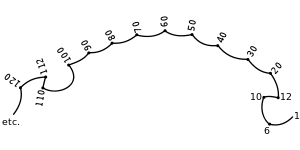Number form
A number form is a mental map of numbers, which automatically and involuntarily appears whenever someone who experiences number-forms thinks of numbers. Numbers are mapped into distinct spatial locations and the mapping may be different across individuals. Number forms were first documented and named by Sir Francis Galton in his The Visions of Sane Persons (Galton 1881a). Later research has identified them as a type of synesthesia (Seron, Pesenti & Noël 1992; Sagiv et al. 2006).
- This article refers to the neurological phenomenon. For Unicode numbers, see Number Forms.

Neural mechanisms
It has been suggested that number-forms are a result of "cross-activation" between regions of the parietal lobe that are involved in numerical cognition and angular gyrus for spatial cognition (Ramachandran & Hubbard 2001; Hubbard et al. 2005). Since the areas that process numerical and spatial representations are close to each other, this may contribute to the increased cross-activation. Compared to non-synesthetes, synesthetes display larger P3b amplitudes for month cues, but similar N1 and P3b responses for arrow (<- or ->) and word (left or right) cues. (Teuscher et al. 2010).
Reaction time research
Reaction time studies have shown that number-form synesthetes are faster to say which of two numbers is larger when the numbers are arranged in a manner consistent with their number-form, suggesting that number forms are automatically evoked (Sagiv et al. 2006; Piazza et al.). This can be thought of as a "spatial Stroop" task, in which space is not relevant to the task, but which can hinder performance despite its irrelevance. The fact that synesthetes cannot ignore the spatial arrangement of the numbers on the screen demonstrates that numbers are automatically evoking spatial cues. The reaction times for valid cues are smaller than invalid cues (words and arrows), but in synesthetes the response time differences for months are larger than those of non-synesthetes (Teuscher et al. 2010).
Differences with number line
These number forms can be distinguished from the non-conscious mental number line that we all have by the fact that they are 1) conscious, 2) idiosyncratic (see image) and 3) stable across the lifespan. Although this form of synesthesia has not been as intensively studied as Grapheme → color synesthesia, Hubbard and colleagues have argued that similar neural mechanisms might be involved, but acting in different brain regions (Hubbard et al. 2005). Future studies will need to be conducted to test this hypothesis.
See also
References
- Ernest, Paul (1986), "Mental number line images" (PDF), Teaching Mathematics and Its Applications, 5 (1): 1–2, doi:10.1093/teamat/5.1.1
- Galton, F. (1881a), The Visions of Sane Persons
- Galton, F. (1881b), "Visualised numerals" (PDF), Journal of the Anthropological Institute, 10: 85–102, doi:10.2307/2841651, JSTOR 2841651
- Hubbard, E. M.; Pinel, P.; Piazza, M.; Dehaene, S. (2005), "Interactions between numbers and space in parietal cortex" (PDF), Nature Reviews Neuroscience, 6 (6): 435–448, doi:10.1038/nrn1684, PMID 15928716
- Piazza, M.; Pinel, P.; Dehaene, S. (2006), "Objective correlates of a peculiar subjective experience: a single-case study of number-form synaesthesia", Cognitive Neuropsychology, 23 (8): 1162–1173, doi:10.1080/02643290600780080, PMID 21049372
- Ramachandran, V. S.; Hubbard, E. M. (2001), "Synaesthesia: A window into perception, thought and language" (PDF), Journal of Consciousness Studies, 8 (12): 3–34, archived from the original (PDF) on 2006-05-27
- Sagiv, N.; Simner, J.; Collins, J.; Butterworth, B.; Ward, J. (2006), "What is the relationship between synaesthesia and visuo-spatial number forms?", Cognition, 101 (1): 114–128, doi:10.1016/j.cognition.2005.09.004, PMID 16288733
- Seron, X.; Pesenti, M.; Noël, M.-P. (1992), "Images of numbers, or When 98 is upper left and 6 sky blue", Cognition, 44 (1–2): 159–196, doi:10.1016/0010-0277(92)90053-K, PMID 1511585
- Teucher, U.; Brang, D.; Ramachandran, V.; Coulson, D. (2010), "Spatial cueing in time-space synesthetes: An event-related brain potential study", Brain and Cognition, 74 (1): 35–46, doi:10.1016/j.bandc.2010.06.001, PMID 20637536